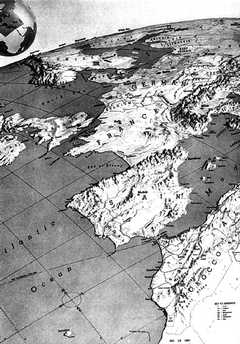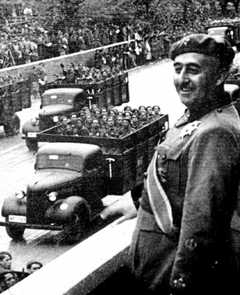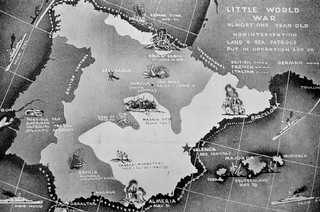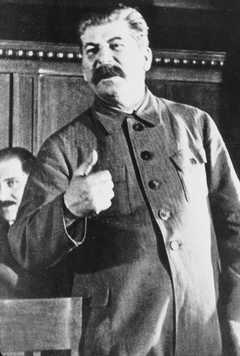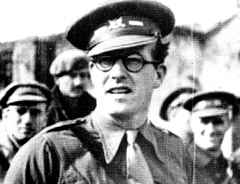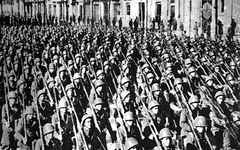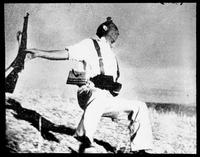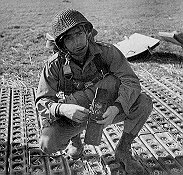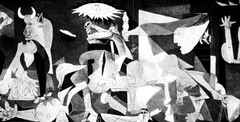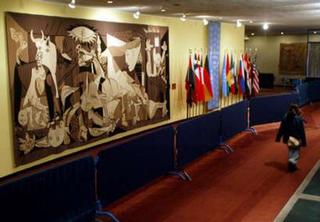Spanish Civil War
|
map from ILN 1943/04/24 - bg
|
|
poster
|
|
Franco
|
|
Little Civil War
|
|
Stalin in peasant jacket 1936/04/23, from FDRL
|
|
Lincoln Brigade
|
|
Robert Merriman
|
|
Italian soldiers in Spain, ILN 1939/03/04
|
|
"Moment of Death" by Capa
|
|
Robert Capa 1944 article
|
|
"Guernica" by Picasso from Reina Sofia
|
|
tapestry copy of "Guernica" donated by Nelson Rockefeller estate has hung in UN hallway outside Security Council since 1985 (AP 2/03)
|
1931 - Spanish Republic proclaimed April 14 - end of the monarchy
- no more King Alfonso 13th - moderates & Pres. Azana elected
1st dimension = a civil conflict
- Republicans vs Loyalists (or Liberals vs conservative Nationalists)
- but anti-monarcy Republican movement divided from beginning:
- socialists, communists, Trotskyite workers party, anarcho-syndicalists (esp. in Barcelona = spontaneous, militant), Basque & Catalonia separatists
1933 elections - won by conservatives
- under clerical leader Gil Robles
- Falange f. - Spanish fascist party
- "In an electoral system that heavily favoured coalitions, the decision of the Socialists to go it alone in the elections of November 1933 was a tragic error. It gave power to a right-wing determined to dismantle the Republic's social reforms. Employers and landowners celebrated the victory by cutting wages, sacking workers, evicting tenants and raising rents. The largest party, the Catholic CEDA, wasn't offered power because the Republican president suspected its leader, Jose Maria Gil Robles, of harbouring fascist ambitions to establish an authoritarian, corporative state. Thus, the conservative Radical Party ruled. " (Paul Preston 1996)
1934 General Strike
- led by the Socialist trade union Union General de Trabajadores (UGT), the anarcho-syndicalist CNT, the communist Alianza Obrera (workers' alliance).
- poster at right from Anarchy Archives collection of Spanish Civil War images
1936 elections - social revolutionaries won narrow victory Feb. 16
- Popular Front organized by Manuel Azana, leader of the Left Republican party, and Indalecio Prieto, centrist leader of the socialist party.
- began revolution against clericals, landowners
- strikes, assass., attacks on church, collectivization of farms
July 17, 1936 - revolt of the Morocco garrison
- Gen. Francisco Franco & army joined conservatives and Catholic CEDA to put down social revolution - became
"Nationalists"
- Republican government tried to use fleet to blockade Franco's Foreign Legion from crossing into Spain
- Franco breaks blockade with Junkers 52 and Savoia-Marchetti transport planes sent by Hitler and Mussolini
by Nov, Republicans in defensive positions - triangle of 3 cities (as well as Basque)
- Madrid, Valencia, Barcelona
- Stalin sends tanks and planes to aid the cities
- newsreels Aug.-Dec. of Madrid, Oviedo sieges
2nd dimension = international conflict
- civil war stalemated - then new dimension added
- foreign powers intervene
- "Little World War" map at right from Time 1937
Italy & Germany = pro-Nationalist
France = pro-Republican (under new Leon Blum & Popular Front)
- July 1935 7th Comintern declared Popular Front
- but French public opinion divided - unable to commit aid
- instead, joined Britian as neutral
Russia = pro-Republican; aid began after Oct. 1936
- Stalin sent arms, pilots
- esp. sent political advisors to indoctrinate, take over Republican leadership
- Socialist Juan Negrin becomes premier May 1937
3rd dimension = ideological conflict
- International Brigades
- young anti-fascist idealists from Eng, France, Italy, Germany
- Italian anti-fascist brigade defeated Mussolini's fascist troops at Guadalajara 1937
Abraham Lincoln Brigade from U.S.
- led by Capt. Robert Merriman - 450 Americans volunteer
- called
"a young communist"but mysterious
- 1st action - Jarama valley - 127 killed
- images at right from Marion Merriman's book
Robert Capa's photos
- "Moment of Death" published in Life magazine 1937/07/12)
Ernest Hemingway's novels
- in 1940 publishedFor Whom the Bell Tolls
George Orwell - came home disillusioned
- in 1938 published Homage to Catalonia about Republican dissension, communist deceit
- in 1949 pub'd 1984 - about totalitarianism
1937 reached crisis - defense of Madrid ag. 4 converging fascist columns
- while a
"5th column"betrayed the Republicans inside the city
Germany tests new weapons
- Junkers Trimotor bombers, Heinkel fighters, incindiary bombs
Guernica bombed Apr. 26, 1937
- Pablo Picasso's modern artwork
"Guernica"was returned in 1981 to the Prado in Madrid after 42 years at the Museum of Modern Art in New York - see Picasso's Guernica Unveiled - 1500 dead, 800 wounded
- old town completely destroyed but arms plant and railroad were undamaged, and the symbolic Basque tree and Basque archives were also undamaged
- done by German Condor Legion at suggestion of Franco, not Hitler. The Nationalists denied the bombing and attempted to put the blame on the Republicans or the Basques. This is the argument of Luis Brolin in his 1967 book Spain, the Vital Years.
- The story written by George Steer for the London Times April 27 and reprinted in the New York Times April 28 put the blame on the fascists and created the myth of Guernica as the innocent victim of a terrorist bombing: "Guernica was not a military objective.... The object of the bombardment was seemingly the demoralisation of the civil population and the destruction of the cradle of the Basque race." However, Hugh Thomas in his 1961 book The Spanish Civil War, and Phillip Knightley in his 1975 book The First Casualty, argue that it was bombed for tactical military objectives.
May 31, 1937 - German warships killed 19 in a bombardment of the Republican coastal town of Almeria, in retaliation for the bombing of the German battleship Deutschland, and in June, after the German cruiser Leipzig claimed it was attacked by Republican submarines, Germany and Italy withdrew from the joint naval patrol that had been established by the Non-Intervention Committee in April.
mid-1938 - Stalin decided to stop aid to Republicans
- western democracies not helping, Franco winning military battles
- Stalin's disillusionment with West would lead to Nazi-Soviet Pact Aug. '39
Jan. 1939 - Barcelona fell
Feb. 10, 1939 - Catalonia fell
March - Valencia and Madrid fell
100,000's refugees fled Spain for France, North Africa, Mexico
- schoolteacher Murray Burnett visited Europe, returned to write 1940 play Everybody Comes to Rick's, that became the 1942 Hal Wallis film Casablanca, with Bogart playing the fictional American Rick Blaine who once ran guns in Ethiopia and fought in Spain.
Franco's rule was harsh; imprisoned 1 million after end of war
According to Ambass. Willard Beaulac's memoirs, Franco became a "silent ally" of U.S. during WWII
U.S. recognized Franco April 3, 1939
U.S. Response:
Jan. 6, 1937 - Mandatory Spanish Arms Embargo passed
- According to Robert Dallek, FDR tied himself to inflexible policy of supporting Anglo-French policy of preventing any spreading of local conflicts into world war.
- FDR also embroiled in Supreme Court plan after Feb 5.
|
FDR's inauguration Jan. 20, from FDRL
|
May 1 - FDR signed 1937 Neutrality Act
- mandatory arms embargo with belligerents
- mandatory travel ban on belligerent ships
- mandatory loan ban to belligerents
- mandatory ban on arming of American merchant ships trading with belligerents
- discretionary cash-and-carry for 2 years (Bernard Baruch's plan to allow trade with belligerents in non-contraband goods if paid in cash and carried in foreign ships)
Links:
- images from Illustrated London News (ILN), Franklin D. Roosevelt Library (FDRL), Time and Life magazines. See image page for additional images and maps.
- Carroll, Peter N. The Odyssey of the Abraham Lincoln Brigade: Americans in the Spanish Civil War. Stanford, Calif.: Stanford University Press, 1994. An account of the Lincoln Brigade of 2800 American volunteers who fought in the Spanish Civil War from January 1937 to October 1938 against Franco, with high casualties and 1/3 dead.
- Dallek, Robert. Franklin D. Roosevelt and American Foreign Policy. NY: Oxford, 1979.
- Merriman, Marion and Warren Lerude. American Commander in Spain: Robert Hale Merriman and the Abraham Lincoln Brigade. Reno: University of Nevada Press, 1986.
- Preston, Paul. "Viva la Revolucion," New Statesman & Society, Feb 16, 1996, v9 p18 (4). This article is critical of the Ken Loach film Land and Freedom that argues "the fight of the brigaders and of the Spanish people was not a fight against Spanish fascism and its German and Italian allies, but rather part of an internecine leftist in which the central enemy was the Communist Party. Despite many merits, Loach's script seems oblivious of two central facts about the Spanish civil war: in its origins, it was a Spanish social war and, in its course and outcome, it was an episode in a greater European civil war that ended in 1945."
- Swan, Christopher, "Museo del Prado" from Christian Science Monitor, July 10, 1984.
- Guernica in Reina Sofia Museum
- The Abraham Lincoln Brigade Archives (ALBA)
- Spanish Civil War index from Canadian Forces College
- Spanish Civil War maps from World War II maps of the Animated Atlas Project and Glyn Harris
- articles on reserve: Robert Capa
Films:
- 1936/08/10 Hearst Complete Newsreel. LATEST FILMS OF SPAIN'S CIVIL WAR. Dramatic phases of the frightful struggle revealed in exclusive pictures taken by Metrotone cameramen as government forces shell rebel strongholds in battle for Madrid! Scenes in the capital and at the Guadarrama front as Death Battalion of women joins motley army! First views of widespread destruction in a war that threatens annihilation to all Spain. (HNR Vol.7-No.293)
- 1936/09/09 Universal newsreel - Terrified Civilians Flee Air Raid (1) "Cordoba, Spain: Government bombers drone through the blue over the rebel-held city, sending civilians racing in terror for cellars and other hiding places as they loose a rain of bombs. Soldiers dig trenches in the streets, fearing the Loyalist advance. - SAN SEBASTIAN: Bitter fighting between Government militia and insurgents continues, with the Republicans shown capturing a Fascist sniper. - PAMPLONA: The rebels put tiny children in black shirts and teach them to march with older girls. - PUERTO CRISTO, MALLORCA: A column of Catalan volunteers lands on the historic Mediterranean island to attempt its capture." scenes of Spanish Civil War (Universal 8-492 - some French narration in this mostly silent newsreel) - DVD51
- 1936/11/09 Universal newsreel - Siege of Oviedo - "Oviedo, Spain: Convoys of food break through the iron ring of Asturian miners surrounding the long-besieged city, bringing needed supplies to the insurgents within who have been standing off dynamiting by the Loyalists for many weeks." (Universal 8-509 silent) - DVD44
- 1936/12/16 RUSSIAN SHIPS DEFY BLOCKADE. Barcelona rejoices as Soviet craft elude) the Spanish Insurgent's warships. (HNR Vol.8-No.226)
- 1936/12/23 MADRID UNDER SIEGE - GRIM DRAMA OF WAR! Latest films from Spain's capital depict scenes of terror as populace flees Insurgent's bombs. A heart rending document of war at its most frightful, with sudden death stalking a great city day and night. (HNR Vol.8-No.228)
- Newsreels on Spain 1930-39
